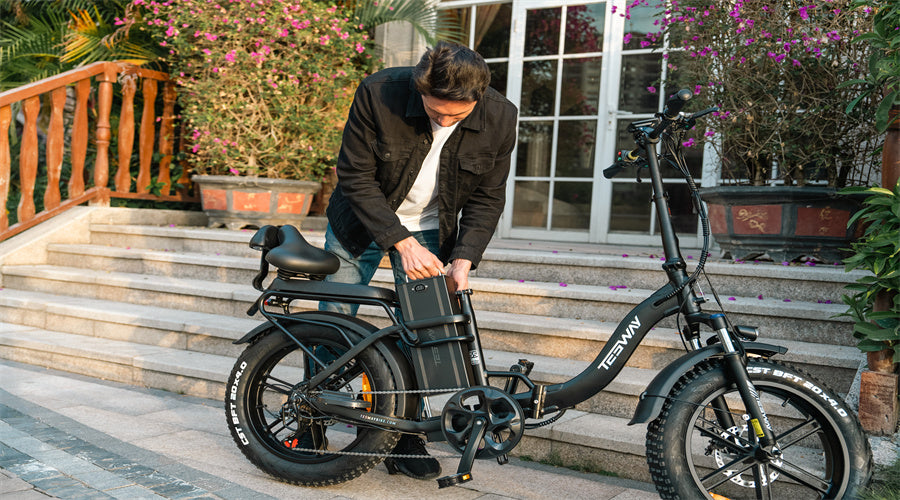Ebike rack mounts are essential accessories for transporting your electric bicycle securely.
They are designed to fit into the receiver hitch of a vehicle, providing a stable and reliable platform for your ebike.
The choice between a 2-inch and a 1-1/4-inch mount hinges on several factors, including your vehicle's hitch size, the weight of your ebike, and your specific transportation needs.
You could get the reliable electric bike at Tesway!
Hitch Receiver Sizes
2-Inch Hitch Receivers
The 2-inch hitch receiver is a standard size found on many SUVs, trucks, and larger vehicles.
This size offers a higher weight capacity, making it suitable for heavier loads, including multiple ebikes. Key features include:
2-inch receivers can typically support up to 500 lbs, making them ideal for carrying heavier ebikes or multiple bikes.
The larger size provides enhanced stability and reduces sway during transportation.
Compatible with a wider range of accessories and attachments, including cargo carriers and larger bike racks.
1-1/4-Inch Hitch Receivers
The 1-1/4-inch hitch receiver is commonly found on smaller vehicles, such as sedans, compact SUVs, and some mid-size cars.
While it has a lower weight capacity, it is sufficient for most standard ebikes. Key features include:
Suitable for vehicles with limited space or lower ground clearance.
Typically supports up to 200 lbs, which is sufficient for one or two standard ebikes.
Easier to install and handle due to its smaller size.
Key Differences Between 2-Inch and 1-1/4-Inch Ebike Rack Mounts
Weight Capacity
One of the most significant differences between the two sizes is their weight capacity.
A 2-inch rack mount can handle more weight, making it ideal for carrying heavier ebikes or multiple bikes.
On the other hand, a 1-1/4-inch mount is suitable for lighter loads and fewer bikes.
Stability and Durability
A 2-inch mount provides greater stability, reducing the chances of the rack swaying or wobbling during transit.
This is particularly important for long trips or rough terrains.
The 1-1/4-inch mount, while stable, may not offer the same level of sturdiness, especially when loaded to its maximum capacity.
Vehicle Compatibility
The choice between a 2-inch and a 1-1/4-inch mount also depends on your vehicle’s hitch receiver.
Most larger vehicles come with a 2-inch receiver, while smaller cars are equipped with a 1-1/4-inch receiver.
Ensuring compatibility with your vehicle’s hitch receiver is crucial for safe and secure transportation.
Ease of Installation
Installing a 2-inch rack mount can be more challenging due to its size and weight. It often requires additional tools and assistance.
Conversely, a 1-1/4-inch mount is generally easier to handle and install, making it a convenient option for those who frequently attach and detach their bike racks.
Comparative Analysis of Pros and Cons
2-Inch Ebike Rack Mounts
Pros:
Higher Weight Capacity: Supports up to 500 lbs, ideal for multiple ebikes.
Greater Stability: Reduced sway during transport, enhancing safety.
Durability: Built for heavy-duty use and rough terrains.
Versatility: Compatible with various accessories and larger vehicles.
Cons:
Heavier and Bulkier: More challenging to install and handle.
Higher Cost: Generally more expensive than 1-1/4-inch mounts.
Not Suitable for Smaller Vehicles: May not fit smaller cars with lower ground clearance.
1-1/4-Inch Ebike Rack Mounts
Pros:
Compact and Lightweight: Easier to install and manage.
Cost-Effective: Often less expensive.
Suitable for Smaller Vehicles: Perfect for compact cars and urban environments.
Adequate for Standard Loads: Supports up to 200 lbs, suitable for one or two standard ebikes.
Cons:
Lower Weight Capacity: May not support heavier ebikes or multiple bikes.
Less Stability: Potential for more sway during transport, especially on rough terrains.
Limited Compatibility: Fewer accessories and vehicle types compared to 2-inch mounts.
How to Choose an Ebike Rack Mount
Weight of Your Ebike
Evaluate the weight of your ebike(s) to determine the appropriate rack mount.
If you have a heavy-duty ebike or plan to transport multiple bikes, a 2-inch mount is the better choice. For standard ebikes, a 1-1/4-inch mount may suffice.
Frequency of Use
Consider how often you will be using the rack mount.
Frequent users may benefit from the durability and stability of a 2-inch mount, while occasional users might prefer the convenience of a 1-1/4-inch mount.
Type of Vehicle
Ensure your vehicle’s hitch receiver is compatible with the chosen rack mount.
Adapters are available, but using the correct size is generally more secure and straightforward.
Budget
Cost can be a deciding factor. 2-inch mounts are typically more expensive due to their higher capacity and enhanced features.
Installation Considerations
- Ease of Installation: Choose a mount that you can install and remove easily.
- Security: Ensure the mount provides a secure fit to prevent theft and accidents.
- Accessories Compatibility: Check if the mount can accommodate additional accessories you may need.
Conclusion
Choosing between a 2-inch and a 1-1/4-inch ebike rack mount depends on various factors, including the weight of your ebike, your vehicle type, and your specific transportation needs.
Each option has its advantages and is suited to different requirements.
By understanding these differences, you can select the right ebike rack mount to ensure safe, secure, and convenient transportation of your ebike.
FAQs
Can a 1-1/4-inch rack mount handle two ebikes?
Yes, a 1-1/4-inch rack mount can handle two standard ebikes, provided their combined weight does not exceed the mount's capacity, typically around 200 lbs.
Is there a significant difference in stability between 2-inch and 1-1/4-inch mounts?
Yes, 2-inch mounts generally offer greater stability and reduced sway during transport, especially important for heavier loads and rough terrains.
Are there any accessories that only fit 2-inch rack mounts?
Yes, some accessories, such as larger cargo carriers and certain heavy-duty bike racks, are specifically designed to fit 2-inch rack mounts due to their higher weight capacity.







Share:
11 Disadvantages of Fold-up Electric Bikes
Bike History | What Makes Electric Beach Cruisers So Awesome?